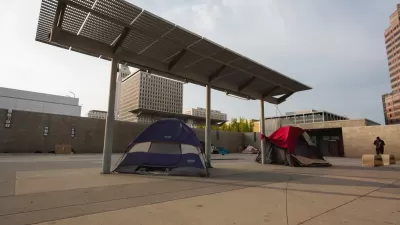The last decade saw a lethal combination of higher temperatures, rapid population growth, and rising eviction rates.

“Relentless heat led to 645 deaths last year in Maricopa County, the most ever documented in Arizona’s biggest metropolitan area,” reports Ariel Wittenberg in Politico. That amounts to a 1,000 percent increase in the last decade, growth attributed to longer, more intense heat waves coupled with rising eviction rates that put more Phoenix residents outdoors and at risk.
According to Wittenberg, “Almost half of the victims last year were homeless — 290 people. Twenty died at bus stops, others were in tents, and an unrecorded number of people were found on the pavement, prone as if on a baking stone.”
The city is using federal funding to operate cooling centers with longer hours, but these lifelines face an uncertain future when those funds run out. “With no stable federal funding, the location of cooling centers and bottled water distribution points changes each year, depending on whether fleeting resources will be provided by the city, county or state. Churches and local charities supplement government aid with their own donations of water and cool spaces,” Wittenberg explains.
While some city councilors don’t want to see resources used to assist unhoused people, Phoenix is one of the cities that is — by necessity — taking extreme heat seriously as a public health hazard, creating a new city office to spearhead heat mitigation strategies. At the state level, an Extreme Heat Preparedness Plan resulted in a new statewide cooling center coordinator and a chief heat officer.
FULL STORY: ‘Just brutal’: Why America’s hottest city is seeing a surge in deaths

Planetizen Federal Action Tracker
A weekly monitor of how Trump’s orders and actions are impacting planners and planning in America.

Canada vs. Kamala: Whose Liberal Housing Platform Comes Out on Top?
As Canada votes for a new Prime Minister, what can America learn from the leading liberal candidate of its neighbor to the north?

The Five Most-Changed American Cities
A ranking of population change, home values, and jobs highlights the nation’s most dynamic and most stagnant regions.

San Diego Adopts First Mobility Master Plan
The plan provides a comprehensive framework for making San Diego’s transportation network more multimodal, accessible, and sustainable.

Housing, Supportive Service Providers Brace for Federal Cuts
Organizations that provide housing assistance are tightening their purse strings and making plans for maintaining operations if federal funding dries up.

Op-Ed: Why an Effective Passenger Rail Network Needs Government Involvement
An outdated rail network that privileges freight won’t be fixed by privatizing Amtrak.
Urban Design for Planners 1: Software Tools
This six-course series explores essential urban design concepts using open source software and equips planners with the tools they need to participate fully in the urban design process.
Planning for Universal Design
Learn the tools for implementing Universal Design in planning regulations.
New York City School Construction Authority
Village of Glen Ellyn
Central Transportation Planning Staff/Boston Region MPO
Institute for Housing and Urban Development Studies (IHS)
City of Grandview
Harvard GSD Executive Education
Regional Transportation Commission of Southern Nevada
Toledo-Lucas County Plan Commissions





























